When the warm days announce that it’s tomato growing season and you’re ready to choose which varieties to include in your garden, there are many characteristics to consider.
What will they taste like? How big will they get? What do they look like? Are they determinate or indeterminate?
If you get to that last question and your eyes glaze over, don’t worry. You’re not alone.
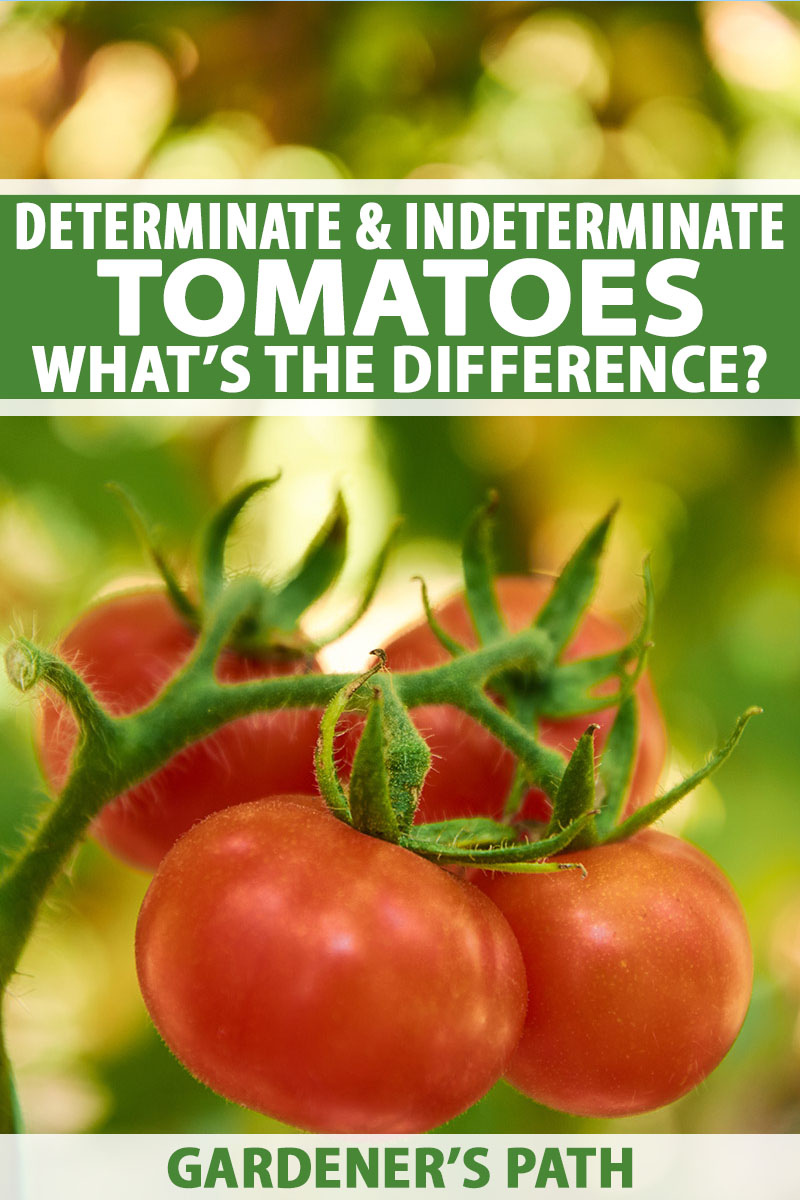
We link to vendors to help you find relevant products. If you buy from one of our links, we may earn a commission.
I used to just ignore that particular information too – after all, the words “determinate” and “indeterminate” just don’t awaken the senses the way vivid flavor descriptions or unique color patterns do.
But I’m here to tell you why you might want to pay attention to those words from now on.
Whether your tomatoes are determinate or not can affect quite a few factors related to how you grow them – and having this knowledge can mean the difference between producing a good harvest, and a great one.
Before I get down to the details, here’s a quick overview of what I’m going to cover:
What You’ll Learn
Growth Habit Terms
Whether a cultivar is determinate or indeterminate refers simply to its growth habit – or in other words, how the plant behaves and develops.
And tomatoes aren’t the only ones that have these distinctions. Potatoes, cucumbers, and beans are among the edible crops that also exhibit determinate or indeterminate growth habits among different cultivars.

Here’s what these terms mean:
- Determinate plants grow to a certain point, and then stop, with a shorter stature overall.
- Indeterminate tomato plants keep growing and producing fruit all season.
- Semi-determinate varieties keep growing through the season, but generally remain smaller than indeterminate plants, with a bushier habit.
Here’s a non-plant example to illustrate these terms. We human beings exhibit determinate growth in our life cycles.
We don’t just keep growing and growing – when we reach maturity, we stop growing taller.
Human hair, on the other hand, shows indeterminate growth, giving us the ability to grow super long locks – reminiscent of country music star Crystal Gayle – if we should so choose.
But what do these various growth habits mean for you and your garden? I’ll get to that shortly.
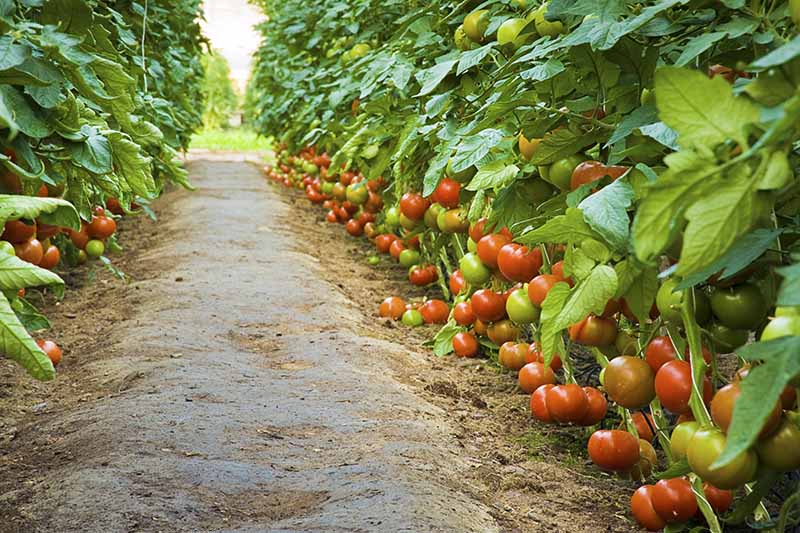
Now that you have a general idea of what these terms mean, you may be wondering how you can tell which category a particular cultivar falls into. A little bit of research is going to be key here.
Here’s how you can establish whether a variety is determinate, indeterminate, or semi-determinate:
- If planting from seed, check your seed packets for this information.
- If you’re browsing seeds online, the seller should supply this information in the description of the cultivar.
- If you’re buying plants at a garden center or nursery, plant tags may be marked with this information along with the variety name.
Finally, if you’re already growing a tomato plant that has buds or flowers and you’re not sure what type of growing habit it may have, look for its highest stem or leader, which is the growing tip.
Are there leaves or flowers (or flower buds) on the growing tip?
If you see flowers or flower buds, it’s probably determinate. If there are leaves there, the plant is most likely indeterminate. I’ll go into this in a bit more detail below.
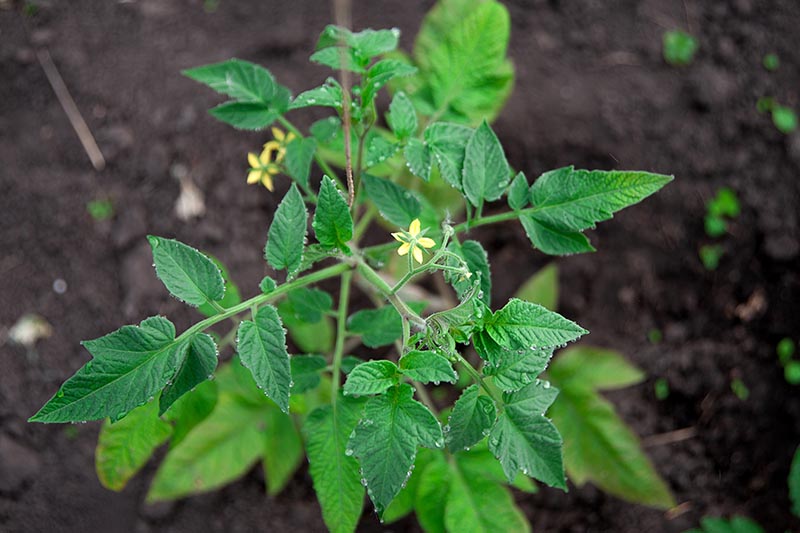
When you’re planting your tomatoes, it’s important to have a handle on their growth habit before you get them in the ground.
This will help you to provide them with the best care – and will enable you to reap the best harvests.
Whether your chosen variety is determinate, indeterminate, or semi-determinate will change the way you go about the following tomato gardening tasks:
- Pruning
- Removing suckers
- Staking
- Growing in containers
- Harvesting
- Canning
Or, at least it should change how you plan for and go about these things. Armed with the tips in this article, you’ll know what to do!
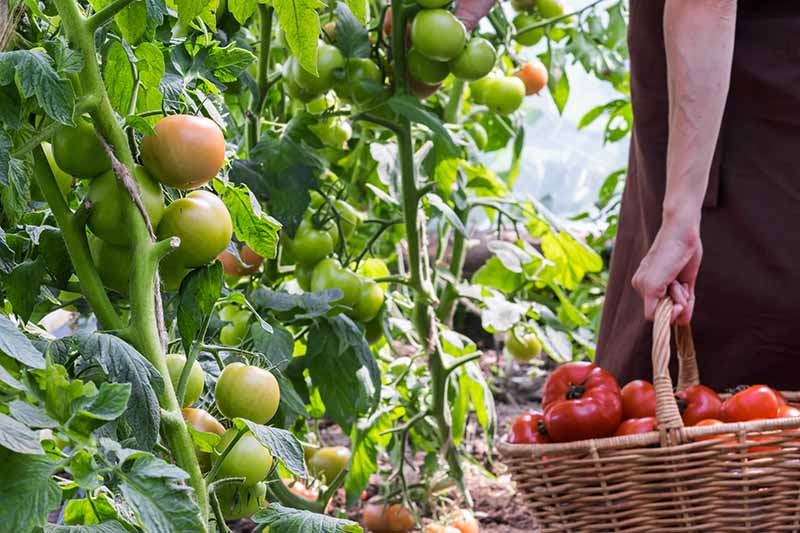
Ready to get down and dirty with the details of these different growth habits? Let’s start with the determinate cultivars.
Care for Determinate Types
Determinate tomato cultivars are also sometimes referred to as “bush” cultivars, because of their bushy shapes.
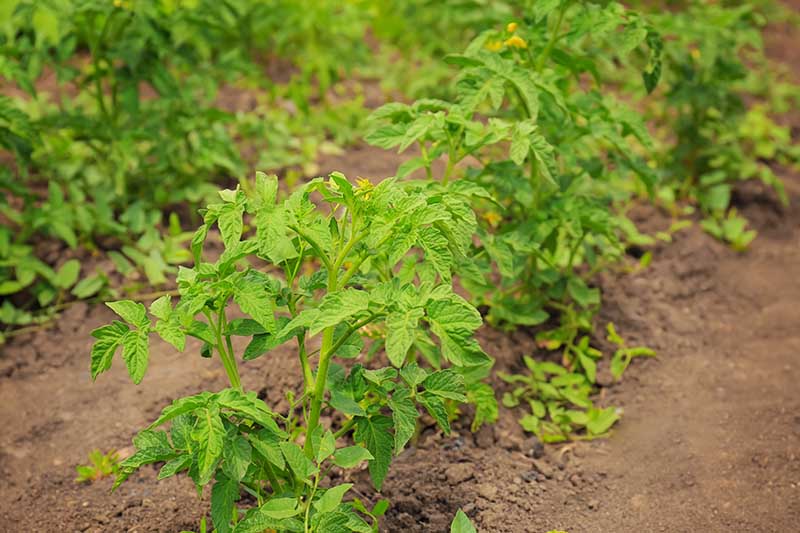
What causes that bushiness?
It all comes down to genetics. To put it simply, a determinate tomato plant has a self-pruning gene. The effects of this gene show up in the plant’s growing tip or shoot.
As mentioned above, indeterminate varieties have growing tips that end in leaves; determinate tomatoes have growing tips that end in flower clusters, and eventually fruit – there’s that self-pruning gene showing up.
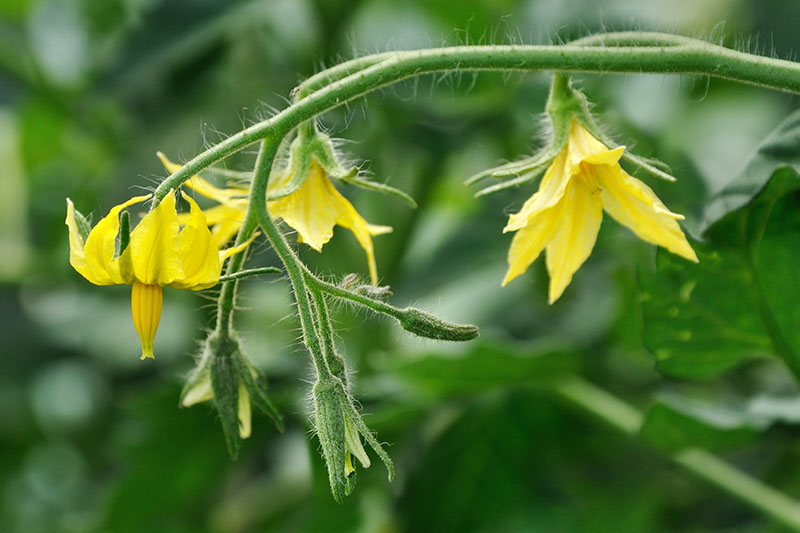
When these flower clusters bloom, foliage growth is effectively halted, allowing the plant to instead put its energy into reproduction, or in other words, turning pollinated flowers into fruit.
Since the plant’s stems and foliage stop growing, the overall size of the plant stays smaller and more compact.
The plant is “self-pruned,” so to speak, because it can’t keep growing foliage from its flower clusters.
That means that when these plants are in your garden, they will reach a staked or caged height of four feet or less, depending on your cultivar.
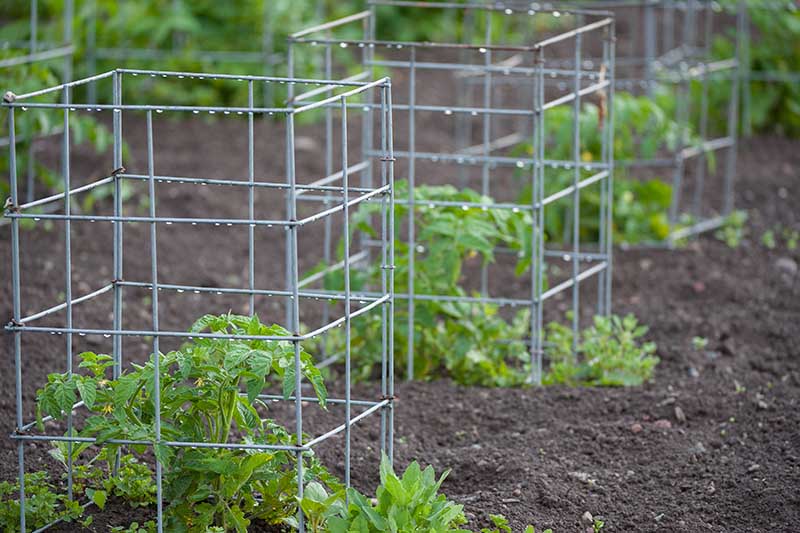
These tomatoes have sturdy stems and require only minimal support, compared to indeterminate vining types. You may even be able to grow them without stakes, cages, or trellises.
Compact growth habit varieties – a subset of determinate types – may be grown without any support, and can produce just as heavy a yield as staked crops, without the grower having to invest in the equipment or the time involved in staking.
In my garden in northeast Utah, I don’t stake my determinate tomatoes.
The growth of most of my garden crops is limited by the extreme conditions here, and plants just don’t grow as vigorously – even my vining tomatoes don’t grow as tall as they would have in my home state of North Carolina.
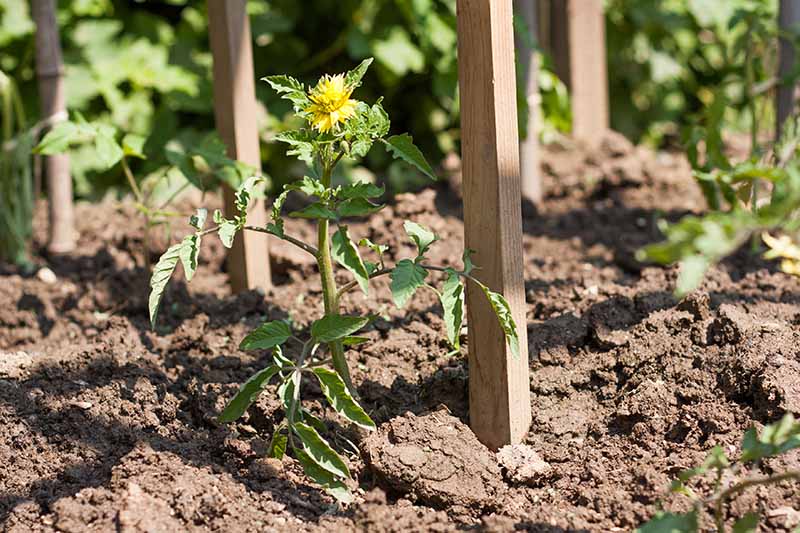
However, most gardeners offer some support for determinate varieties, to help them bear what will be a heavy load of fruit when they reach maturity.
The Florida weave, also known as the basket weave system, is considered by many gardeners to be the best support for determinate tomatoes.
If you want to learn more about this trellis system, in which twine is attached to stakes and woven around plants to provide support as they grow, make sure you read our article on the Florida weave.
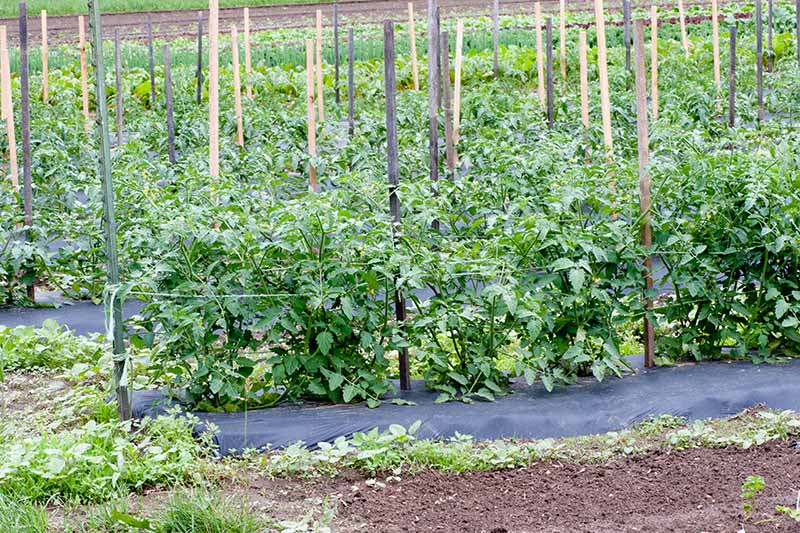
Determinate tomatoes aren’t going to keep growing endlessly, so they generally aren’t pruned throughout the growing season, apart from an initial pruning of the lower part of the plant to keep foliage off of the soil and to prevent the spread of disease.
Kathryn Fontenot at the Louisiana State University AgCenter Extension recommends working your way up from the soil, and removing suckers up to the first cluster of flowers.
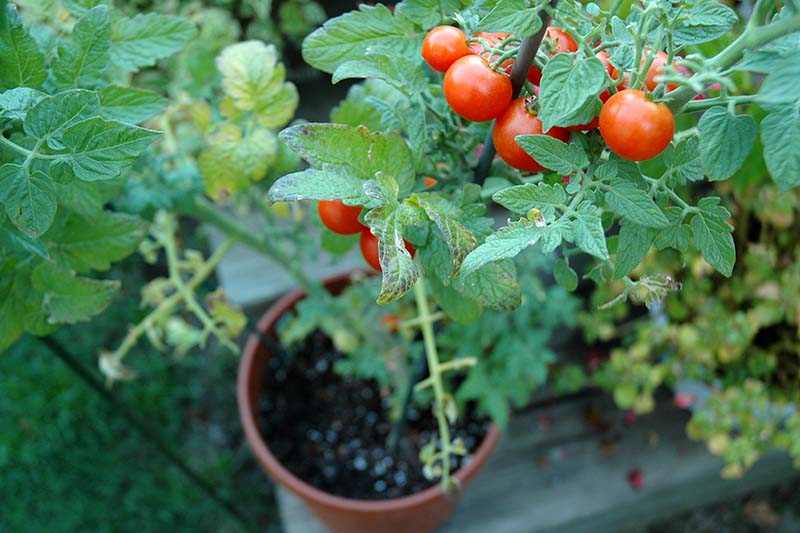
Determinate varieties make great candidates for container gardening or growing in smaller spaces, thanks to their smaller stature.
And these cultivars have another benefit:
For short-season growers such as myself, the fruits of most (but not all) determinate cultivars tend to mature earlier than indeterminate ones – which can sometimes mean the difference between a tasty homegrown harvest, and no harvest at all.
If you are in the market for a short-season tomato, make sure to check the number of days to maturity for the variety, whether it’s determinate or not.
And if you are planning to start your plants from seed, be sure to build the additional days required into your calculations as well.
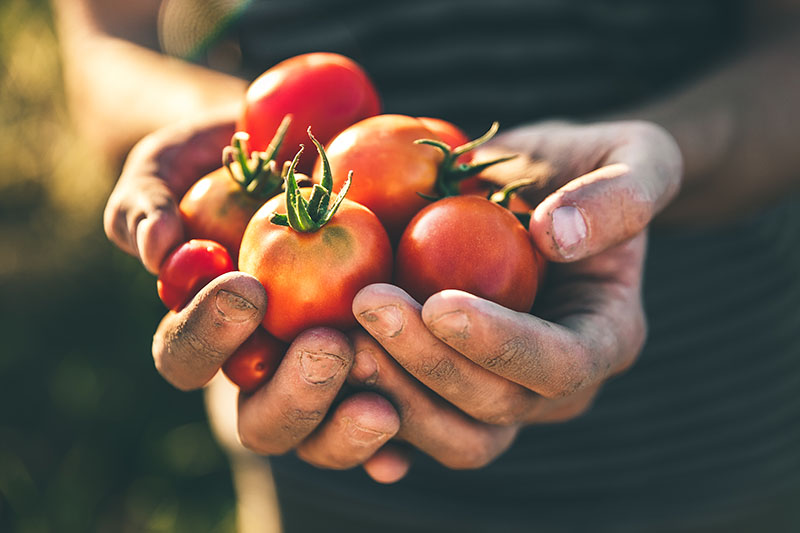
Determinate tomatoes produce most of their fruiting flowers at the same time. That means if you go look at your plants, all of the flowers should seem like they are pretty much on the same schedule.
And since the flowers bloom at the same time, the fruits will also all ripen pretty much at the same time – within a period of a few weeks.
This means the bulk of your harvest will come in over a short, concentrated period, making these varieties excellent for canning.
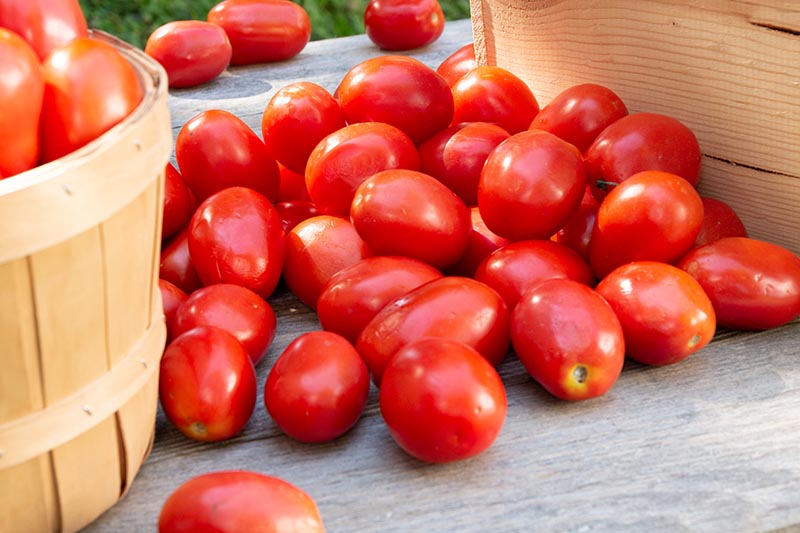
Determinate varieties are heavily used in commercial production of canned tomato products because of this convenient timing – and many determinate varieties are available to home gardeners, too.
One popular determinate variety that is widely available to home gardeners in both seed catalogs and nursery centers is ‘Roma.’
‘Roma’ is an open-pollinated paste variety. It’s determinate, so the fruits are ready to harvest pretty much all at once – making canning much easier to organize.
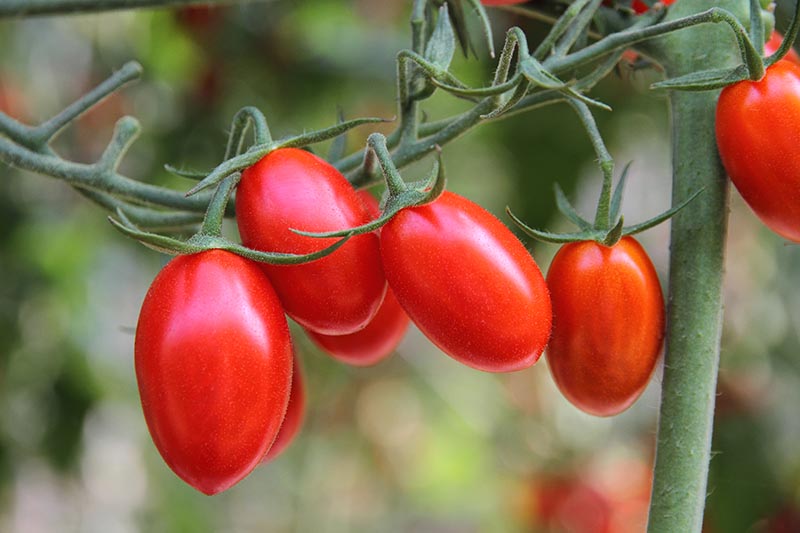
But if canning isn’t on your agenda, paste types – also known as plum or processing tomatoes – like ‘Roma’ are also ideal for cooking, because they are meaty and less watery than the juicy slicers that you might like to serve fresh on a burger.
I have to say – paste tomatoes are my absolute favorites to cook with!
The fruits of this cultivar weigh about six to seven ounces each.
‘Roma’ matures late, and fruits will be ready to harvest about 80 days after transplanting.
Organic ‘Roma’ seeds are available for purchase in a selection of packet sizes from Eden Brothers.
Care for Indeterminate Types
Also called vine, pole, or climbing tomatoes, indeterminate cultivars just keep growing and growing until something stops them – usually your first fall frost.
Gardeners with long growing seasons can take advantage of this trait, receiving small but frequent harvests from each plant after it reaches maturity and throughout the growing season.
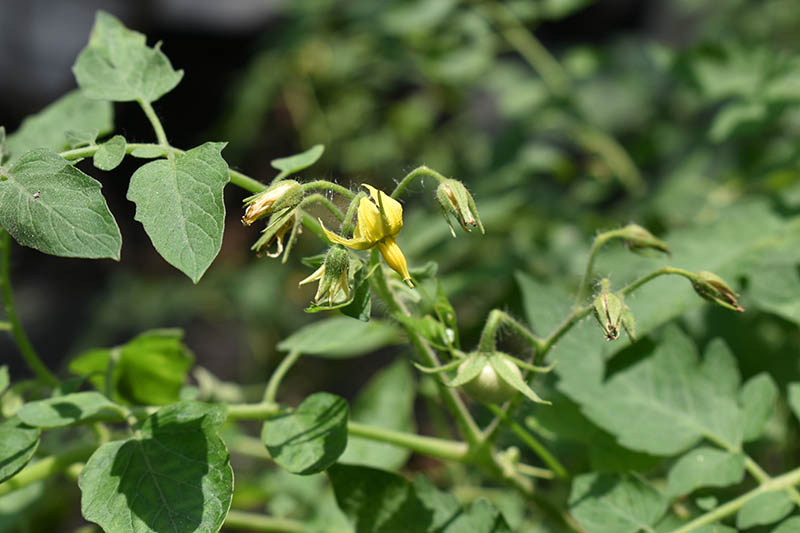
Remember how our determinate varieties grow flowers on the ends of their shoots? Indeterminate types grow flower clusters along the sides of their stems instead, which allows the shoot to keep growing.
The plant’s energy keeps going into growing more foliage along with producing fruit, which results in smaller quantities of fruit over an extended period of time.
If your first fall frost tends to come early, like it does in my short-season garden, you may not have time to get much of a harvest from the later-maturing indeterminate varieties – so make sure you pick one that is appropriate for the length of your growing season.
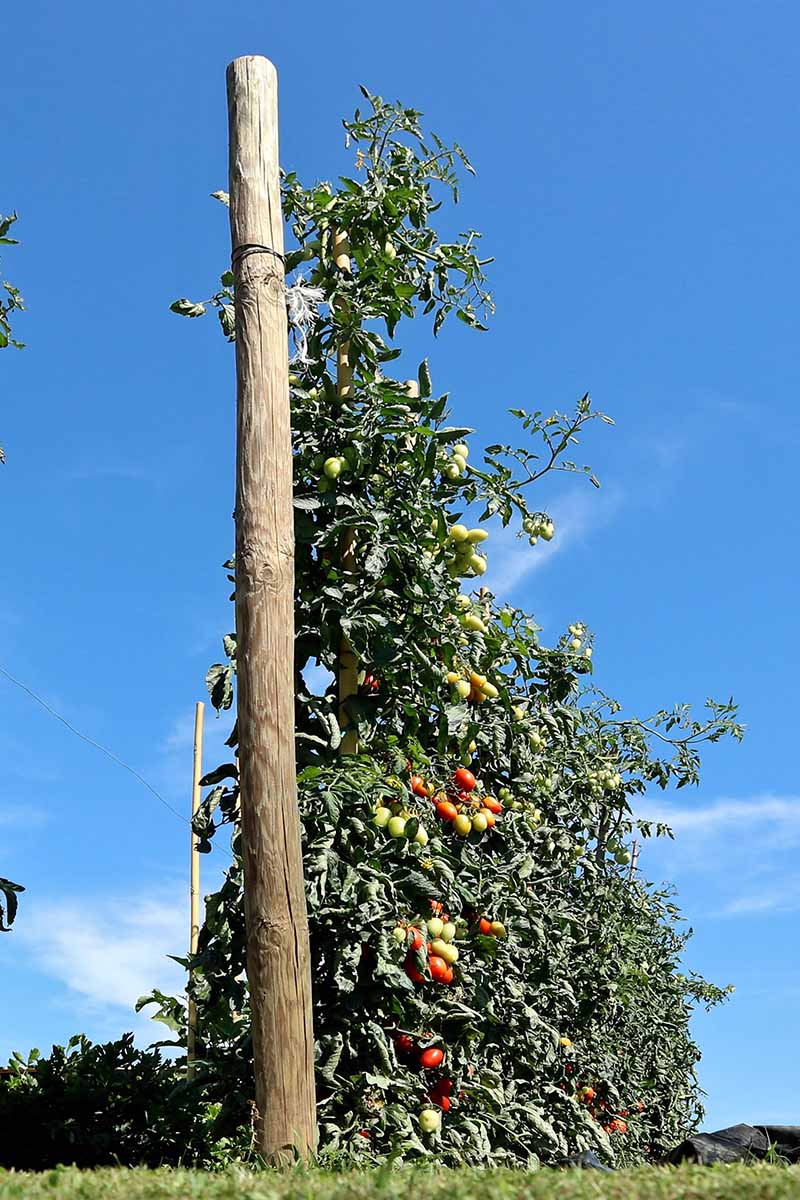
If given the time though, indeterminate tomato plants often grow to be 10 to 12 feet in height or more.
Because of this extensive growth, these cultivars aren’t usually the best choice for growing in containers.
They can become too top-heavy for container gardening – and if the plant grows quite tall, its roots will grow extensively as well, requiring more water and nutrients than may be manageable in a container setup.
On the other hand, they are wonderful candidates for vertical gardening, since it’s easy to train them to climb upwards.
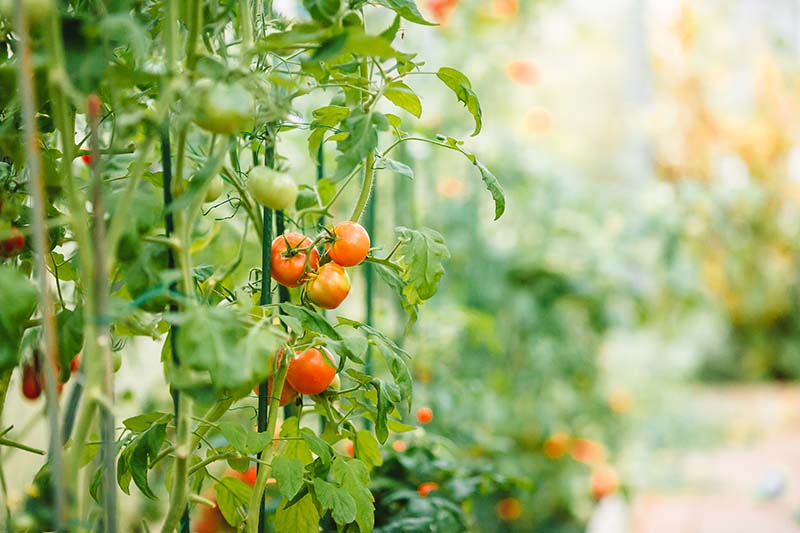
Whereas some determinate varieties can get by without support, these varieties need to have their rampantly growing vines managed. This is usually done with pruning and staking.
Climbing types are typically pruned to just one or two leader stems, and trained to climb a string or trellis.
Pruning and training these plants in this way also helps with airflow, an important tactic for keeping disease at bay in more humid climates.
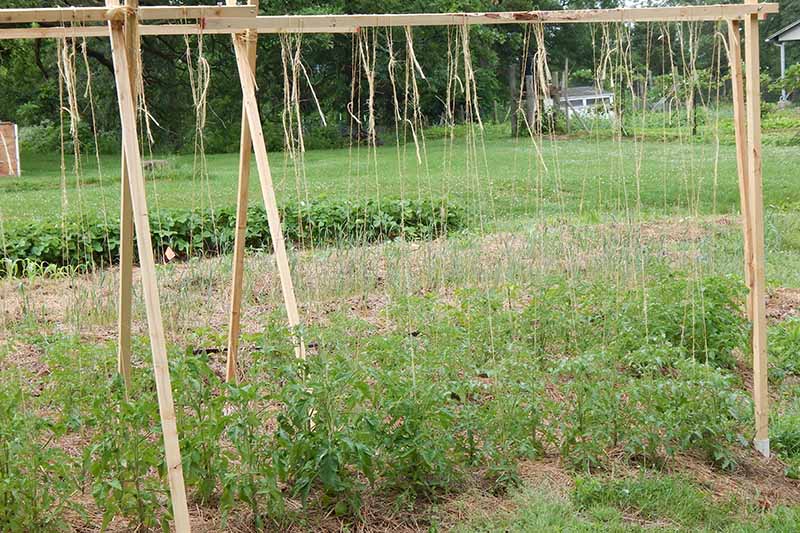
With indeterminate varieties, pruning and removing suckers allows the plant to focus energy on fruit production for the remaining stems – putting less energy into foliage growth.
In fact, unpruned, overgrown plants may produce fruits that fail to turn red on the vine. Read our article on this topic to learn more about how to make sure this summer crop turns red in your garden.
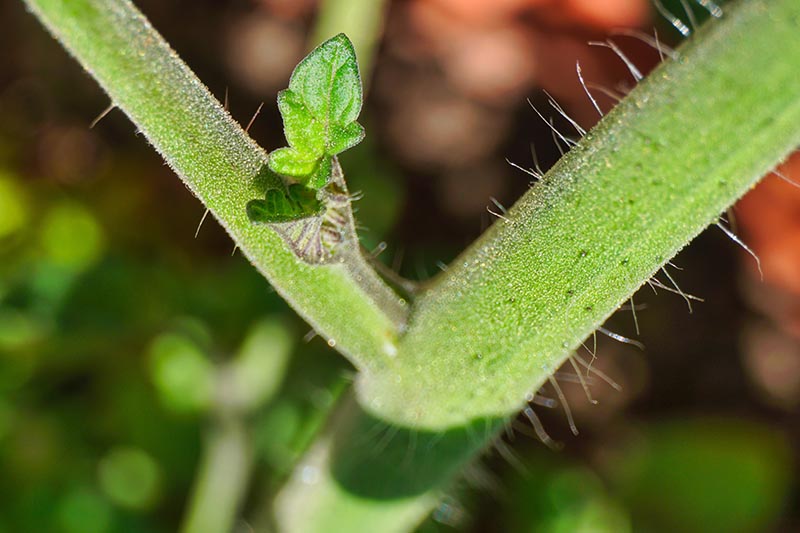
Speaking of red fruit – you’ll notice that indeterminate cultivars will often have flowers, immature fruit, and ripe fruit on the plant all at the same time.
Instead of producing all of their fruit more or less at once, as determinate varieties tend to do, indeterminate ones gradually produce smaller but more frequent harvests over the growing season.
These varieties are great if you want to have a steady harvest throughout your growing season – just make sure to grow several plants if you want tomatoes on your menu every single day.
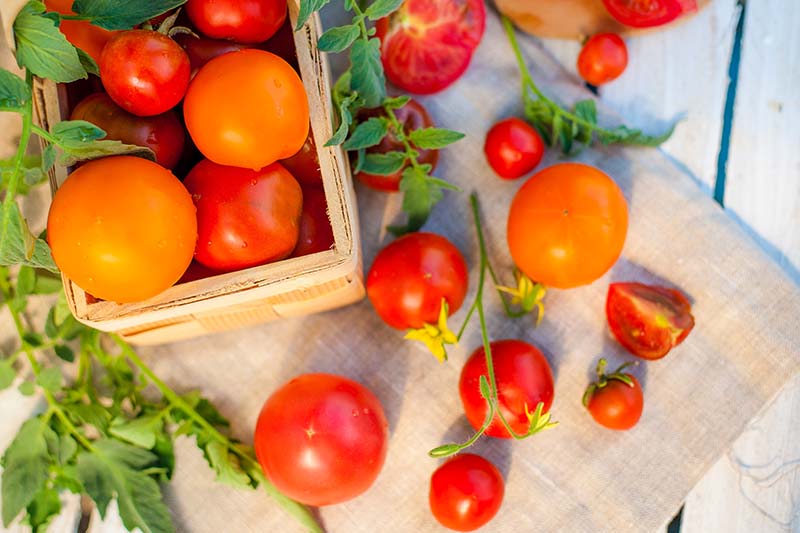
That doesn’t mean you can’t also use indeterminate varieties for canning, though.
There are many delicious paste varieties that are indeterminate, such as ‘San Marzano.’
To can these cultivars, the trick is to grow several plants at once, so that you have enough fruit ripening at the same time for canning.
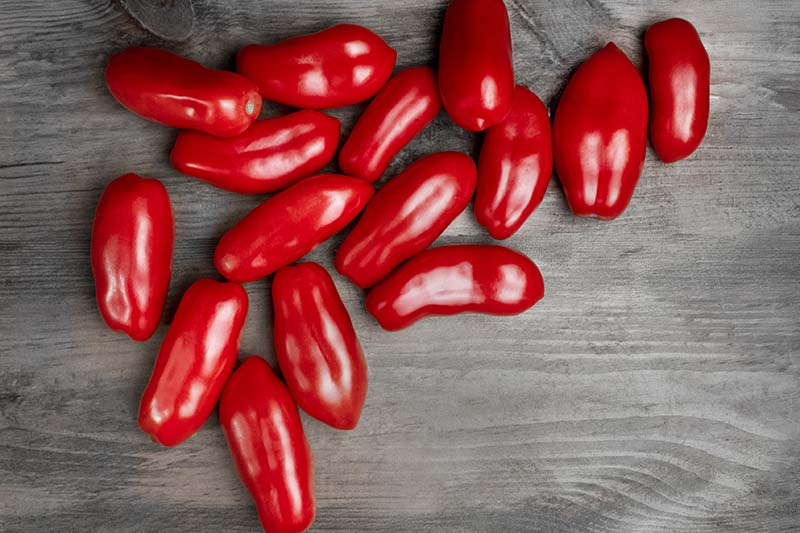
Most heirloom and large-fruited tomatoes are indeterminate. But not all indeterminates are large or heirlooms! There are many small-fruited varieties that have this growth habit as well.
One of my favorite cherry tomatoes, ‘Chadwick Cherry,’ is an indeterminate cultivar. The fruits weigh about 1 ounce each, a bit larger than the average cherry tomato.
This late-maturing variety will reach a height of about five feet when staked, so it remains fairly manageable, and it’s suitable even for smaller spaces like a patio.
It’s also disease resistant, and produces heavy yields about 85 days from transplanting.
You’ll find ‘Chadwick Cherry’ seeds for purchase in a selection of package sizes from Mountain Valley Seed Company via True Leaf Market.
Care for Semi-Determinate Types
Semi-determinate tomatoes might just be the best of both worlds – well-behaved, bushy plants that produce fruit all summer long.
These are actually a subtype of the determinate variety.
Remember that self-pruning gene? Semi-determinates have it too.
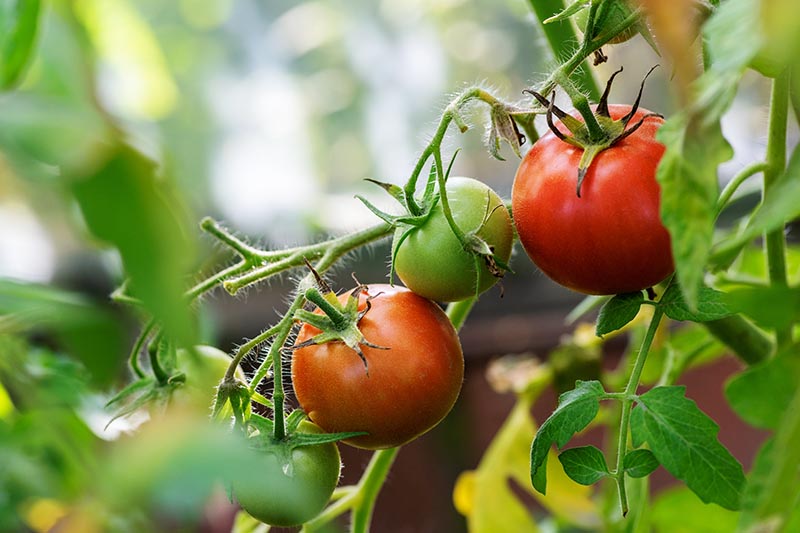
Like determinate cultivars, semi-determinate types produce flower clusters at the ends of their stems.
And yet, they continue producing fruit longer than determinate types, acting more like those with an indeterminate growth habit.
As far as support goes, they are treated largely like determinate types – both cages and the Florida weave will work well if you’re growing these.
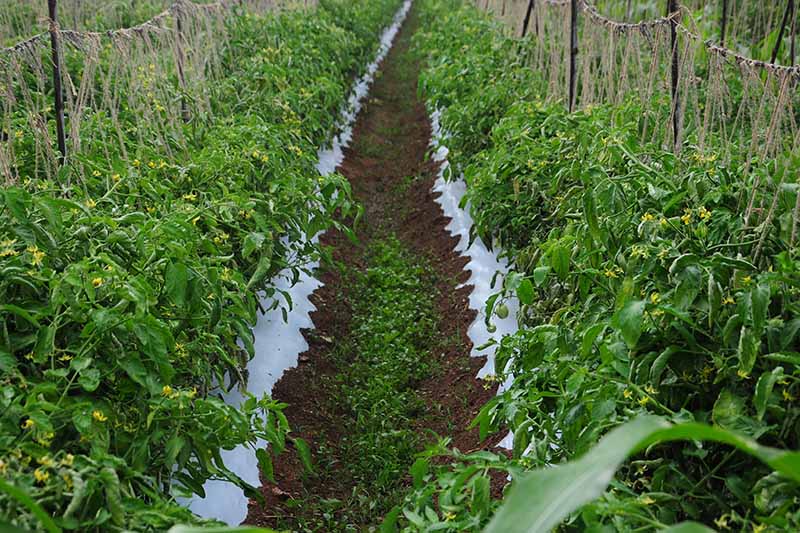
While initial pruning of lower foliage and suckers below the first flower cluster is recommended, with semi-determinate cultivars, further pruning and removal of suckers is optional.
Since these plants are fairly compact and sturdy, they do well in containers.
Semi-determinate tomato cultivars tend to have a large amount of fruit come to maturity early in the summer, and then they continue to set fruit less abundantly throughout the growing season.

There are many semi-determinate cultivars available to the home grower, with a wide range of uses – from slicers for fresh eating to paste types for canning, to cherries for plein-air nibbling.
In my opinion, one of the tastiest semi-determinate varieties for fresh eating is ‘Cosmonaut Volkov.’
This cultivar from Ukraine is named in honor of Vladislav Volkov, a Soviet cosmonaut.
The fruits of ‘Cosmonaut Volkov’ are around two to three inches wide, orangish-red with green shoulders and a sweet and tangy flavor. They are one of my husband’s all-time favorites.

This mid-season cultivar will be ready to harvest in 72 days after transplanting.
You’ll find ‘Cosmonaut Volkov’ seeds available for purchase from Sherwoods Seeds via Amazon.
Oh, Behave!
Now that you know how your tomato cultivars are going to behave, you should have an easier time knowing how to give them excellent care in your garden, get bumper crop harvests, and be able to organize your canning and salsa-making projects accordingly.
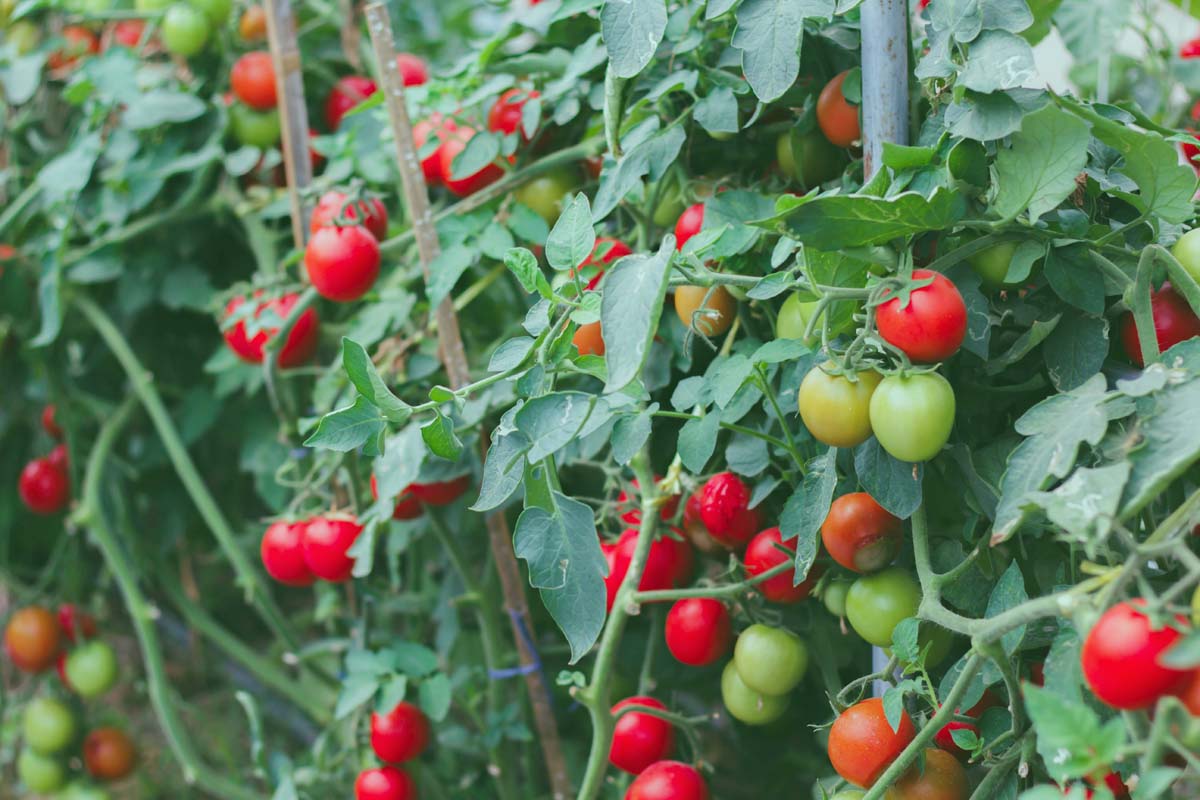
Are you ready to grow some wildly vining indeterminate cultivars? Will you stick with the more well-behaved determinate types?
Or will you choose the middle path that leads to the semi-determinates? Let us know what you’re growing in the comments!
If you’re interested in expanding your knowledge of growing tomatoes, here are a few more articles that may be of interest:
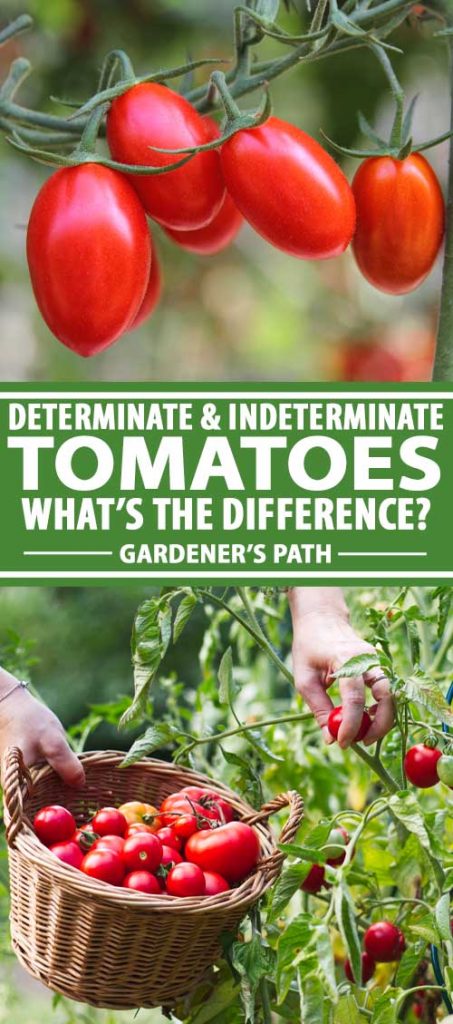
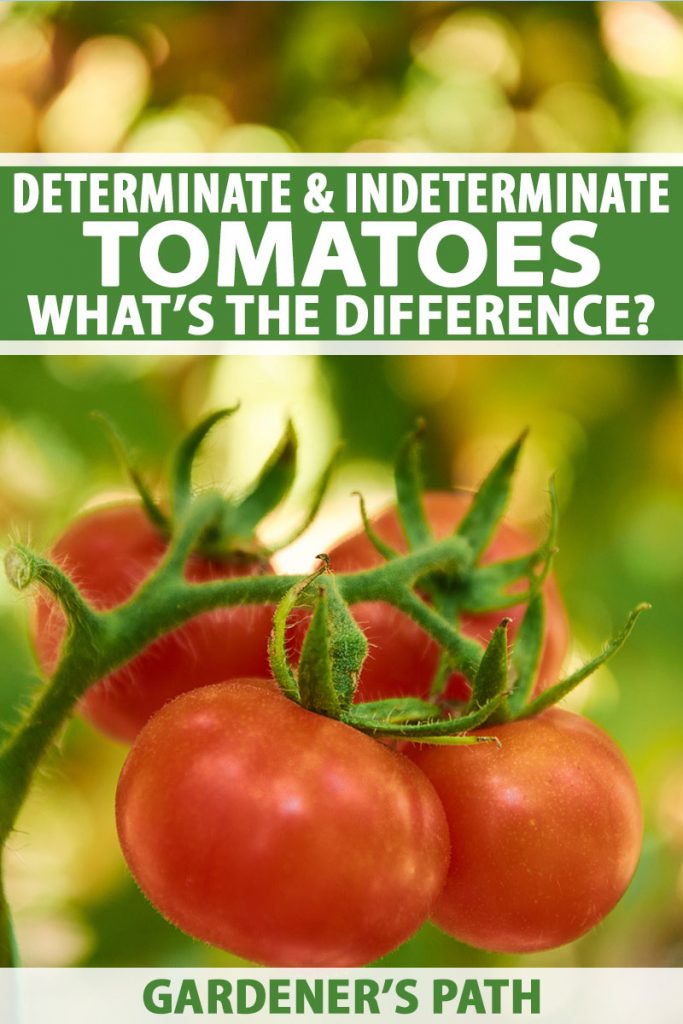
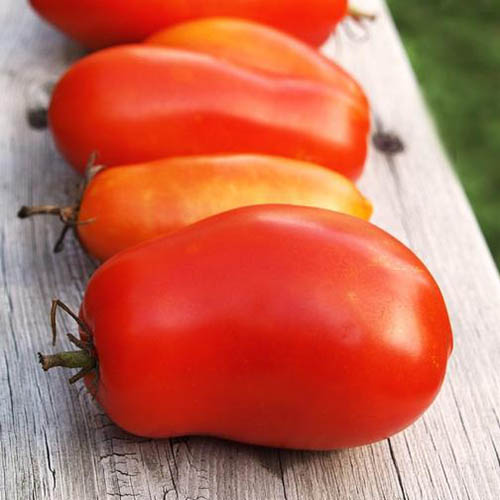
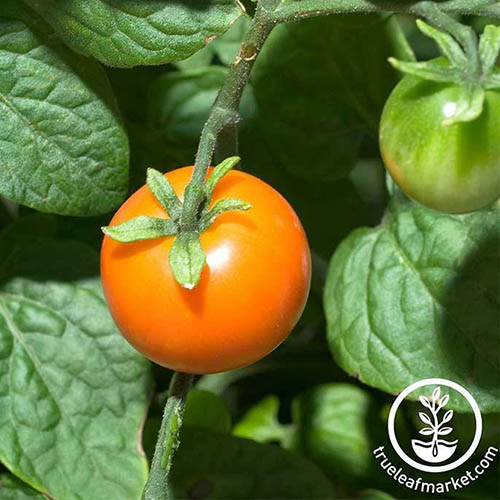
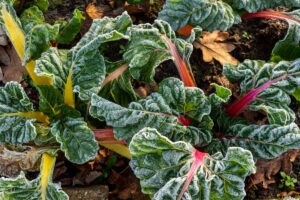
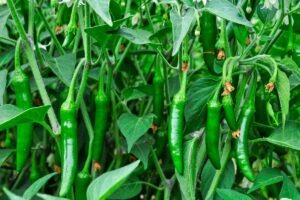
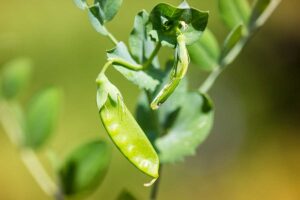
Excellent article. My husband met Ms. Fontenot at our garden center here in Louisiana. We have her book.
Thanks so much for taking the time to leave a comment, Robin – I’m glad you enjoyed the article! And just in case any of our readers in Louisiana are wondering, I think the book Robin is referring to is The Louisiana Urban Gardener by Kathryn Fontenot. Copies are available on Amazon.
I need to learn more, I’m a rookie
Hi Mary,
Everyone’s a rookie at some point! If you need to go back to the basics of tomato growing, I recommend starting with our complete tomato growing guide. I bet it will answer any questions you might have.
Happy gardening!
Very interesting and informative article! I should have read this prior to planting my tomatoes but hopefully ended up with the right varieties for container gardening this rookie season!
Hi Janine,
Thanks for your comment – I’m glad you enjoyed the article! Gardening is a learning process, even for those of us with many years of experience – so you’re in good company! A tomato cage or trellis will help support your plants if they are not a super compact variety – many gardeners like to use this extra support even with determinate types to help support the heavy weight of the tomatoes. Best of luck and happy gardening!
I plan to plant my seeds in soil blocks and then place the blocks on a wicking pad which will probably keep the block wet for a number of days. My fear is root rot. How do I control the moisture better?
Hi David,
I have not yet tried out using soil blocks myself, but I think I would start off by watering them with a mister/spray bottle to best control water, which is what I do any time I’m starting seeds. I think it would be best if you hold off on using the wicking pad until the plants have sized up a bit. They won’t need as much water at first.
Hope this helps!
This is wonderful it has really helped me. And I expect learn more from these articles
Hi there,
Thanks for taking the time to leave a comment! I’m so glad you found this article helpful.
Happy gardening!
Thank you for this info on Tomato types. I am growing Roma and Purple Cherokee tomatoes this year. I made this decision because last year we had so much rain that I lost all my tomatoes because they split. These varieties are supposed to have thicker skin so less splitting according to what I read while researching. Fingers crossed I will have plenty to eat and to can to make spaghetti sauce etc.
Hi Dina,
I’m glad you found this article helpful. I’m a big fan of both Roma type tomatoes and ‘Cherokee Purple.’ Best of luck – I hope you have a bountiful and delicious harvest!
Excellent article. I have one question: is there a chart or list I can get that tells me what varieties are determinant and indeterminate. Or do I have learn the plants. You never know what you are going to buy at home depot.
Hi Karen, Thanks for your kind words about this article. I’m not sure that there’s any definitive list anywhere on determinate and indeterminate tomatoes, because there are a vast number of varieties out there, and breeders are constantly releasing new ones. Any list would be out of date pretty much as soon as it is released. However, we do have a few articles you could refer to: 1) 21 of the Best Heirloom Tomato Varieties for the Garden 2) 17 of the Best Cherry Tomatoes to Plant in Your Garden 3) 23 of the Best Slicing Tomatoes to Grow in… Read more »